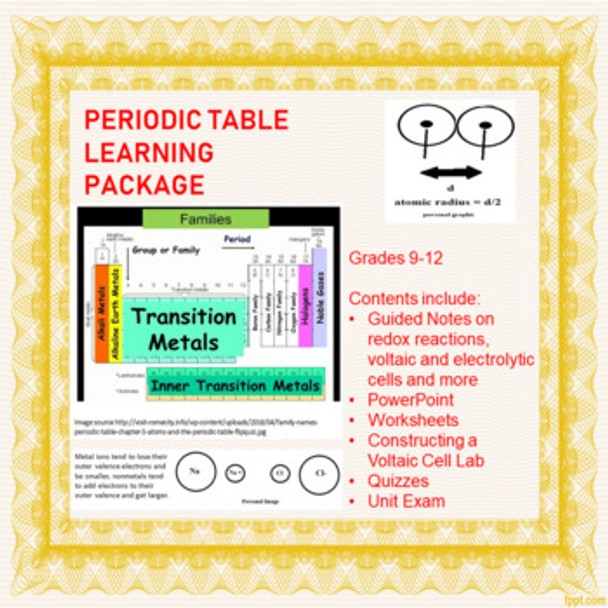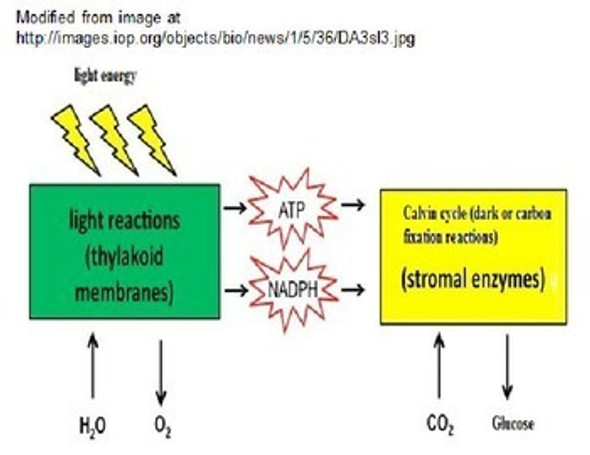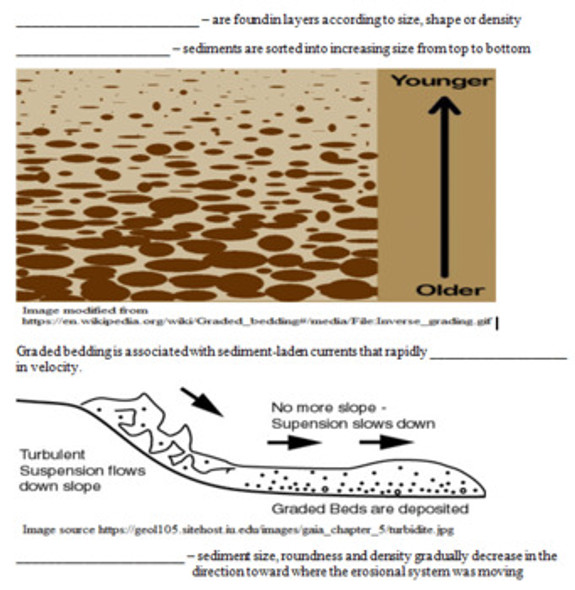Periodic Table Learning Activities (Distance Learning)
- Bulk Pricing:
- Buy in bulk and save
- Contributor:
- Monday's Rescue
- Grade Level:
- 9-12
- Product Type:
- Learning Package Bundle(Notes, PowerPoint, Lab, Homework)
- File Type:
- doc, pdf, ppt
- Pages:
- 47
- Answer Key:
- Yes
Description
This zip file contains many different activities (47 pages of student handouts and 2 PowerPoints with a total of 84 slides) which can be used to compose a unit for chemistry students involving the Periodic Table. This unit can be used most effectively if the students have a basic understanding of valence electrons and how they are involved in bonding. While these lessons were originally designed to correlate to the performance indicators of the New York State Chemistry - Physical Setting curriculum, the components of this lesson may be easily used in other chemistry or physical science courses as well. The components this unit addresses in the NGSS Standards and Common Core Standards are indicated at the end of this description.
Some of the topics addressed in this learning package include periods, families, metals, nonmetals and metalloids. Characteristics of the alkali metals, alkali earth metals, halogens, noble gases, transition elements, carbon and hydrogen are examined as well.
Many documents are included in both word and pdf to allow editing for specific teacher needs. These materials are well suited for use in distance learning environments.
The specific contents of the learning package includes the following items (the page count for these items are actual student handouts as answer key page counts are not included):
-- Marzano self assessment scale including learning goals and Common Core Reading/Writing and Mathematics Standards for students specific to this unit (3 pages)
-- Cloze notes handout for students with learning goals and Common Core Standards (8 pages)
-- 30 slide PowerPoint to accompany the cloze notes
-- Periodic Trends Lab with learning goals and correlations to the NGSS and Common Core Standards (8 pages)
-- Potential Energy Diagram Worksheet with key (4 pages) (20 questions)
-- Periodic Table Worksheet # 1 in word and pdf with answer key (28 questions) (3 pages)
-- Periodic Table Worksheet # 2 in word and pdf with answer key (4 pages/32 questions)
-- Periodic Table Reading and Writing Activity correlated to the Common Core (13 pages)
-- Periodic Table Unit Exam in word and pdf format with key (4 pages/33 questions)
-- 25 question Jeopardy review game in PowerPoint format (54 slides)
-- Reference Table for Unit in word and pdf (2 pages)
Learning Goals
Upon the completion of this unit the student will be able to:
1. state the chief difference between Mendeleev's and Moseley's early version of the periodic table.
2. state the difference between groups (families) and periods on the periodic table.
3. describe the location of metals, metalloids, and nonmetals on the periodic table.
4. describe metals in terms of their conductivity, malleability, and ductility.
5. define the terms malleability and ductility.
6. discuss the chemical properties of metals in terms of their electronegativity, ionization energy, and charge of the ions they form.
7. list two or more physical properties of nonmetals.
8. discuss the chemical properties of metals in terms of their electronegativity, ionization energy, and the charge of the ions they form.
9. recognize that metalloids have physical and chemical properties intermediate between metals and nonmetals.
10. define the terms ionization energy and electronegativity and use a reference table to determine their values for a particular element.
11. define the terms atomic radius and ionic radius.
12. recognize and explain why a metal's ionic radius is generally smaller than the radius of atom and a nonmetal's ionic radius is generally larger than radius of atom
13. identify and list two properties of alkali metals.
14. identify and list two properties of alkali earth metals.
15. identify and list two properties of transition metals.
16. identify and list a property of the zinc family.
17. identify and list a property of the boron family.
18. identify and list two properties of the carbon family.
19. identify and list a property of the nitrogen family.
20. identify and list a property of the oxygen family.
NGSS Standards
HS-PS1 Matter and Its Interactions
Students who demonstrate understanding can:
HS-PS1-1. Use the periodic table as a model to predict the relative properties of elements based on the patterns of electrons in the outermost energy level of atoms.
HS-PS1-2. Construct and revise an explanation for the outcome of a simple chemical reaction based on the outermost electron states of atoms, trends in the periodic table, and knowledge of the patterns of chemical properties.
Common Core State Standards
ELA/Literacy
RST.9-10.7 Translate quantitative or technical information expressed in words in a text into visual form (e.g., a table or chart) and translate information expressed visually or mathematically (e.g., in an equation) into words.
WHST.9-12.2 Write informative/explanatory texts, including the narration of historical events, scientific procedures/ experiments, or technical processes.
Mathematics
HSN-Q.A.1 Use units as a way to understand problems and to guide the solution of multi-step problems; choose and interpret units consistently in formulas; choose and interpret the scale and the origin in graphs and data displays.
HSN-Q.A.3 Choose a level of accuracy appropriate to limitations on measurement when reporting quantities.
STAAR Standards
Readiness Standards
C.5.B use the Periodic Table to identify and explain the properties of chemical families, including alkali metals, alkaline earth metals, halogens, noble gases, and transition metals
C.5.C use the Periodic Table to identify and explain periodic trends, including atomic and ionic radii, electronegativity, and ionization energy
Supporting Standard
C.5.A explain the use of chemical and physical properties in the historical development of the Periodic Table
Terms of Use
Purchase of the product is for classroom use by the purchaser only. It is a violation for individuals, schools, and districts to redistribute, sell, or post this item on the Internet or to other individuals.
This work is licensed under a Creative Commons Attribution-NonCommercial-ShareAlike 4.0 International License.
View my complete High School Complete Chemistry Course














